By Leen Randell
Updated: Jul 04, 2024
10 Best Herbal Decoctions For Hay Fever
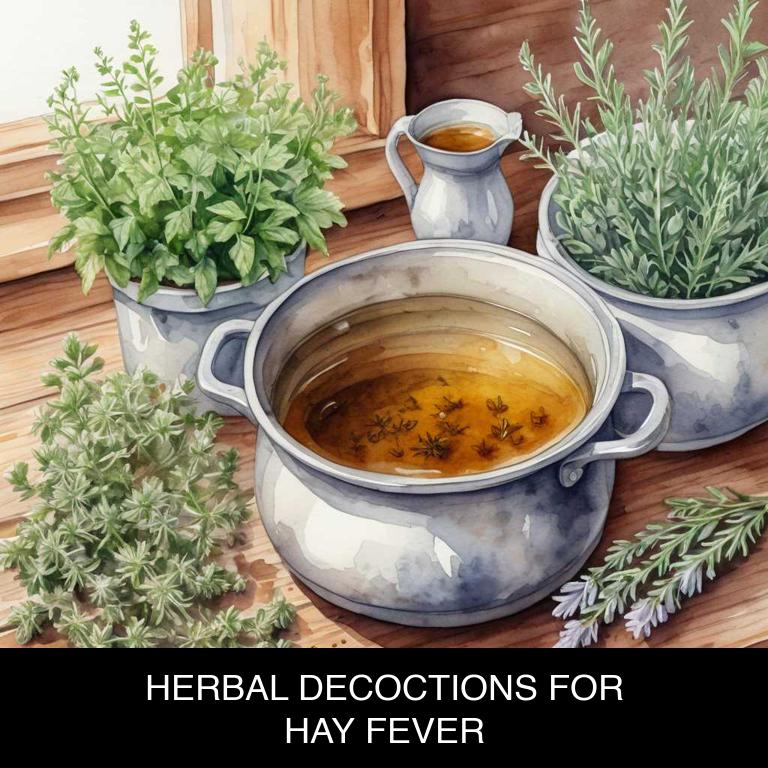
Herbal decoctions for hay fever are a natural and effective way to alleviate symptoms of allergic rhinitis.
These decoctions, made by steeping herbs in hot water, can help to reduce congestion, itching, and sneezing associated with hay fever. Herbs such as butterbur, stinging nettle, and eyebright have anti-inflammatory properties that soothe the nasal passages and sinuses, providing relief from itchy eyes and runny noses.
For example, a warm cup of butterbur tea can help to calm irritated nasal tissues, allowing individuals with hay fever to enjoy outdoor activities without constant sneezing fits or sinus pressure.
The following article describes in detail the most important decoctions for hay fever, including medicinal properties, parts of herbs to use, and recipes for preparations.
- 1. Petasites hybridus
- 2. Ananas comosus
- 3. Urtica dioica
- 4. Quercus robur
- 5. Taraxacum officinale
- 6. Galphimia glauca
- 7. Stellaria media
- 8. Althaea officinalis
- 9. Calendula officinalis
- 10. Plantago major
- What is the best combination of herbal decoctions to use for hay fever?
- What ailments similar to hay fever are treated with herbal decoctions?
1. Petasites hybridus
Butterbur decoctions helps with hay fever because its active compounds, including petasin and isopetasin, have natural anti-inflammatory properties that help alleviate nasal congestion and sinus pressure.
The decoction's flavonoids also work to reduce histamine release, which in turn reduces symptoms such as itching, sneezing, and runny nose.
Additionally, butterbur's antioxidant properties may help protect the respiratory tract from oxidative stress caused by airborne allergens, making it a natural and effective remedy for managing hay fever symptoms.
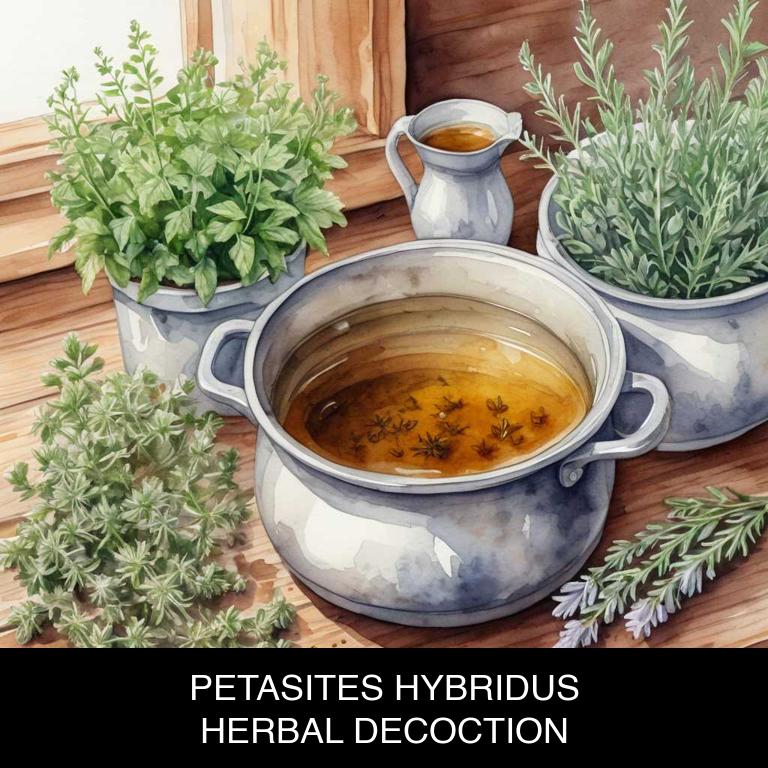
Medicinal Constituents
The list below shows the primary medicinal constituents in Petasites hybridus decoctions that help with hay fever.
- Isoalantolactone: This sesquiterpene lactone has anti-inflammatory properties, which help to reduce the nasal congestion, itching, and runny nose associated with hay fever.
- Alantolactone: Another sesquiterpene lactone, alantolactone also has anti-inflammatory effects, which contribute to its ability to alleviate the symptoms of hay fever, such as sneezing and itchy eyes.
- Petasins: These sesquiterpene lactones are known for their antihistamine properties, which help to block the release of histamine, a chemical responsible for triggering allergic reactions, thereby providing relief from hay fever symptoms.
Parts Used
The list below shows the primary parts of butterbur used to make decoctions for hay fever.
- Roots: They contain compounds that inhibit the production of inflammatory mediators, helping to alleviate hay fever symptoms.
- Leaves: Their decoctions have anti-inflammatory properties that can help to reduce nasal congestion and itching associated with hay fever.
- Stems: The stems of Petasites hybridus contain flavonoids that have anti-allergic and anti-inflammatory effects, making them useful in hay fever treatments.
Quick Recipe
The following recipe gives a procedure to make a basic butterbur for hay fever.
- Harvest petasites hybridus roots and rhizomes in spring or autumn when they are fresh and moist.
- Chop the petasites hybridus roots and rhizomes into small pieces weighing about 20 grams.
- Combine the chopped roots and rhizomes with 500 milliliters of cold water in a saucepan.
- Boil the mixture over medium heat for 10 to 15 minutes then reduce heat to a simmer.
- Strain the decoction through a cheesecloth or a fine-mesh sieve into a cup or bottle.
2. Ananas comosus
Pineapple decoctions helps with hay fever because they contain anti-inflammatory compounds that soothe and calm irritated airways.
The decoctions' natural antihistamines and decongestants help reduce congestion, relieve sinus pressure, and ease coughing. Additionally, pineapple's bromelain enzyme breaks down allergenic proteins, reducing the body's allergic response to pollen and other triggers.
By drinking herbal pineapple decoctions regularly during peak hay fever seasons, individuals can enjoy natural relief from symptoms and improve their quality of life.
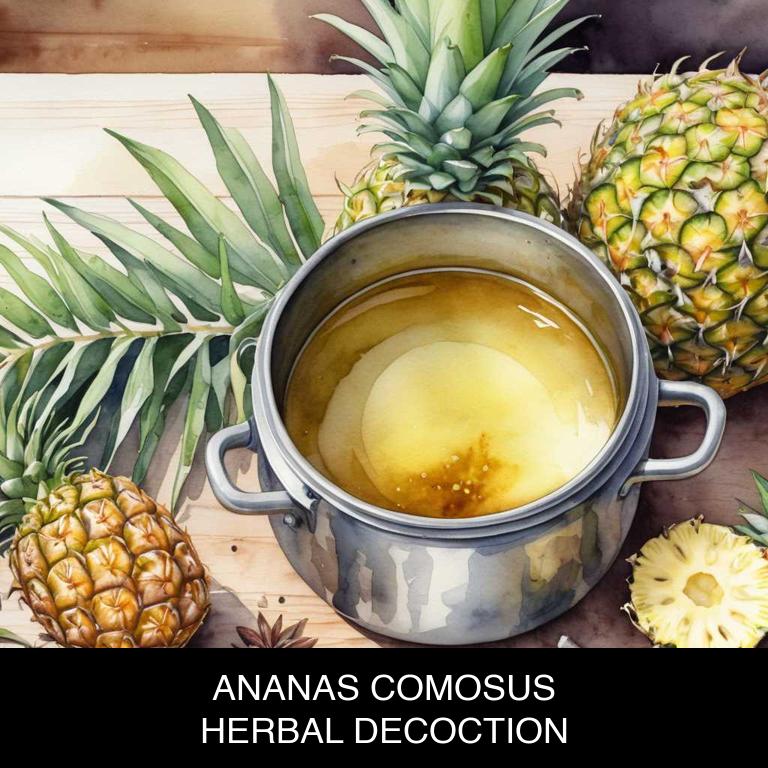
Medicinal Constituents
The list below shows the primary medicinal constituents in Ananas comosus decoctions that help with hay fever.
- Bromelain: A mixture of proteolytic enzymes, including cysteine proteases. Bromelain can help reduce inflammation and congestion in the nasal passages, making it easier to breathe for people with hay fever.
- Vitamin c: A water-soluble vitamin with antioxidant properties. Vitamin C can help reduce oxidative stress and inflammation associated with hay fever, as well as support the immune system to fight off allergens.
- Quercetin: A polyphenolic flavonoid with anti-inflammatory and antioxidant properties. Quercetin can help reduce the release of histamine, a key mediator of allergic reactions, and alleviate symptoms such as itching, sneezing, and congestion.
Parts Used
The list below shows the primary parts of pineapple used to make decoctions for hay fever.
- Leaves: Used for decoctions due to their anti-inflammatory properties, which help alleviate symptoms of hay fever such as congestion and itching.
- Fruits: Used for decoctions due to their anti-inflammatory and antioxidant properties, which help reduce swelling and soothe irritated tissues caused by hay fever.
- Flowers: Used for decoctions due to their flavonoid content, which has anti-inflammatory and antihistamine properties, helping to alleviate hay fever symptoms such as itching and congestion.
Quick Recipe
The following recipe gives a procedure to make a basic pineapple for hay fever.
- Gather ananas comosus fruits and clean them thoroughly with soft brushes under cold running water for 5 minutes.
- Chop the cleaned ananas comosus into small pieces weighing approximately 500 grams.
- Combine the chopped ananas comosus with 4 liters of distilled water in a large saucepan.
- Boil the mixture over high heat for 30 minutes then reduce heat to medium for another 30 minutes.
- Strain the decoction using a cheesecloth or a fine-mesh sieve into a clean container.
3. Urtica dioica
Stinging nettle decoctions helps with hay fever because they contain natural antihistamines that help to reduce the production of histamine in the body.
Histamine is a chemical released during an allergic reaction, which can cause symptoms like runny nose, itchy eyes, and congestion. The decoction's anti-inflammatory properties also help to soothe irritated airways and reduce swelling, alleviating discomfort caused by hay fever.
Additionally, stinging nettle has been shown to increase the production of mucus-clearing agents in the lungs, helping to relieve congestion and make breathing easier.
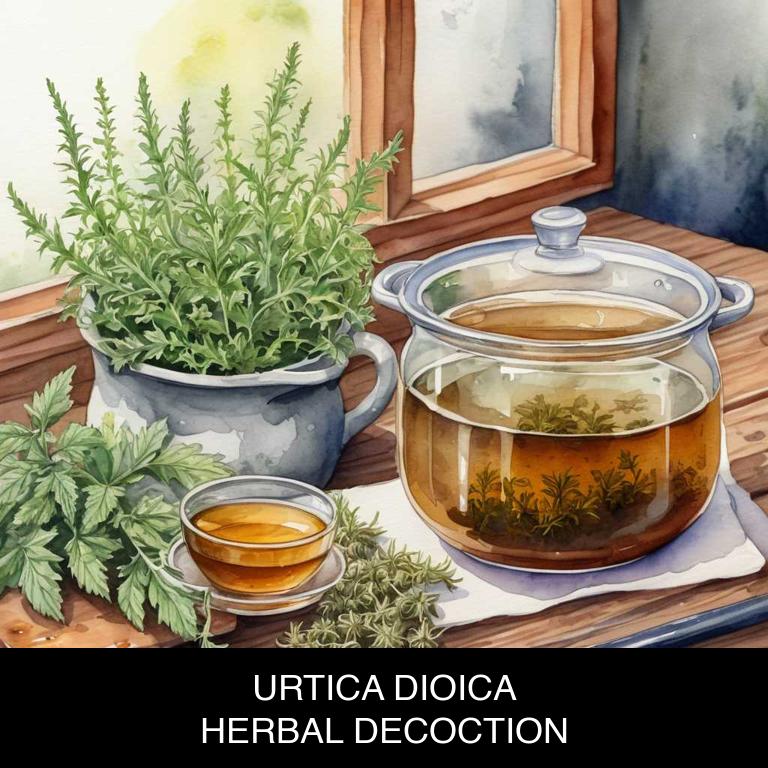
Medicinal Constituents
The list below shows the primary medicinal constituents in Urtica dioica decoctions that help with hay fever.
- Quercetin: A flavonoid phenolic compound, quercetin has anti-inflammatory properties that help alleviate hay fever symptoms by reducing inflammation and stabilizing mast cells.
- Naringenin: A flavonoid, naringenin has been shown to inhibit the release of histamine and other pro-inflammatory mediators, providing relief from hay fever symptoms such as itching, sneezing, and congestion.
- Iridoid glycosides: Iridoid glycosides, particularly aucubin, have been found to possess anti-inflammatory and antihistamine activities, helping to alleviate symptoms associated with hay fever, such as itching and congestion.
Parts Used
The list below shows the primary parts of stinging nettle used to make decoctions for hay fever.
- Leaves: Leaves are the most commonly used part due to their high concentration of histamine-reducing compounds and anti-inflammatory properties.
- Roots: Roots are used for their anti-inflammatory and antihistamine properties, which help alleviate symptoms of hay fever.
- Stems: Stems are used for their similar anti-inflammatory and antihistamine properties to leaves and roots, making them a suitable alternative.
Quick Recipe
The following recipe gives a procedure to make a basic stinging nettle for hay fever.
- Harvest 1/4 cup of fresh or 2 tablespoons of dried urtica dioica leaves and stems for decoction.
- Clean the harvested plant material by rinsing it with cold water to remove any dirt.
- Combine the cleaned urtica dioica plant material with 2 cups of water in a saucepan.
- Boil the mixture over medium heat for 5-10 minutes or until the liquid reduces slightly.
- Strain the decoction through a cheesecloth or a fine-mesh sieve into a clean container.
4. Quercus robur
English oak decoctions helps with hay fever because they contain antihistamine and anti-inflammatory compounds that reduce symptoms such as congestion, itching, and sneezing.
The decoction's flavonoids and tannins work to stabilize mast cells, preventing the release of histamine and reducing allergic reactions.
Additionally, its expectorant properties help to loosen and clear mucus from the airways, making it easier to breathe and providing relief for those suffering from hay fever during peak pollen seasons.
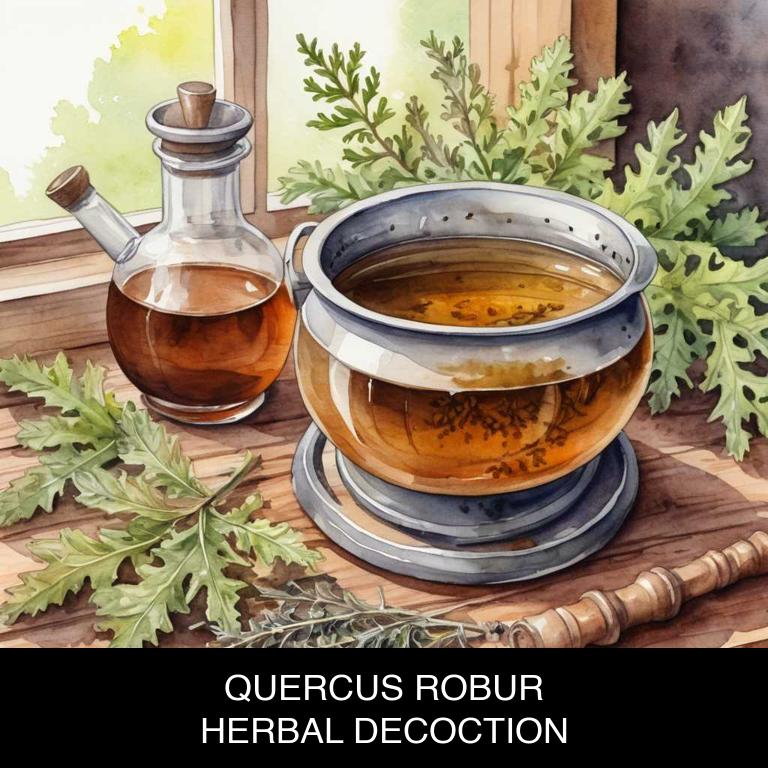
Medicinal Constituents
The list below shows the primary medicinal constituents in Quercus robur decoctions that help with hay fever.
- Flavonoids: Quercetin, a flavonoid present in Quercus robur, helps alleviate hay fever symptoms by acting as a potent anti-inflammatory and antioxidant, reducing histamine release and mitigating allergic reactions.
- Triterpenes: Quercus robur contains triterpenes like ursolic acid, which exhibit anti-inflammatory properties that can help combat hay fever by reducing inflammation in the nasal passages and sinuses, thereby alleviating congestion and discomfort.
- Phenolic acids: Phenolic acids like ellagic acid in Quercus robur have antioxidant properties that can help neutralize free radicals and reduce oxidative stress, which can contribute to hay fever symptoms. This constituent may also exhibit anti-inflammatory and anti-allergic effects.
Parts Used
The list below shows the primary parts of english oak used to make decoctions for hay fever.
- Leaves: They are used due to their high content of quercetin, a flavonoid with anti-inflammatory properties that can help alleviate symptoms of hay fever.
- Barks: The barks are utilized for their astringent and anti-inflammatory properties, which can help soothe respiratory issues and reduce congestion associated with hay fever.
- Fruits: The fruits of Quercus robur, also known as acorns, are used in decoctions as they contain saponins, which can help reduce inflammation and alleviate symptoms of hay fever.
Quick Recipe
The following recipe gives a procedure to make a basic english oak for hay fever.
- Harvest 50g of quercus robur bark in autumn after the first frost for best quality.
- Dry the bark for 2 weeks to reduce moisture content and preserve the herb's properties.
- Grind the dried bark into a fine powder using a mortar and pestle.
- Combine 1 teaspoon of the powdered bark with 250ml of boiling water in a heat-resistant cup.
- Steep the mixture for 15-20 minutes to allow the active compounds to infuse into the water.
5. Taraxacum officinale
Dandelion decoctions helps with hay fever because of its natural anti-inflammatory properties, which help to reduce swelling in the nasal passages and sinuses.
The decoction also contains antioxidants that work to neutralize free radicals, reducing inflammation and congestion caused by pollen exposure. Additionally, dandelion has been shown to have natural antihistamine properties, helping to alleviate symptoms such as itching, sneezing, and runny nose associated with hay fever.
By using dandelion decoctions, sufferers of hay fever can find relief from their symptoms naturally and effectively.

Medicinal Constituents
The list below shows the primary medicinal constituents in Taraxacum officinale decoctions that help with hay fever.
- Taraxasterol: This triterpene helps with hay fever by reducing inflammation and modulating the immune system to alleviate allergic reactions.
- Kaempferol: This flavonoid phenolic compound helps with hay fever by exhibiting anti-inflammatory and antioxidant properties, which can help mitigate the symptoms of allergic rhinitis.
- Quercetin: This flavonoid phenolic compound helps with hay fever by inhibiting the release of histamine and other pro-inflammatory mediators, thus reducing the severity of allergic symptoms.
Parts Used
The list below shows the primary parts of dandelion used to make decoctions for hay fever.
- Flowers: The flowers are the most used part for hay fever decoctions due to their high content of taraxasterol, which is believed to have anti-inflammatory properties.
- Roots: The roots are also used for decoctions, as they contain taraxasterol and other compounds that may help alleviate hay fever symptoms.
- Leaves: The leaves are another part used in decoctions, possibly due to their ability to reduce inflammation and ease congestion associated with hay fever.
Quick Recipe
The following recipe gives a procedure to make a basic dandelion for hay fever.
- Harvest the taraxacum officinale roots and leaves in the morning after the dew has dried from the plant.
- Dry the taraxacum officinale roots and leaves in a single layer at 30 to 50 degrees celsius for 24 hours.
- Measure out 200 grams of dried taraxacum officinale roots and 100 grams of dried taraxacum officinale leaves for the decoction.
- Boil 1 liter of water for 10 minutes then add the measured taraxacum officinale roots and leaves.
- Simmer the decoction for 15 minutes then strain and discard the solids to obtain the final decoction.
6. Galphimia glauca
Yellow flower decoctions helps with hay fever because they contain natural antihistamines that alleviate symptoms such as congestion, itching, and sneezing.
The flowers' anti-inflammatory properties also reduce swelling in the nasal passages, making breathing easier. Additionally, these decoctions have been shown to stabilize mast cells, which are responsible for releasing histamine during an allergic reaction, thereby reducing the body's allergic response.
By drinking a yellow flower decoction, individuals with hay fever can find relief from their symptoms and enjoy the outdoors without discomfort.
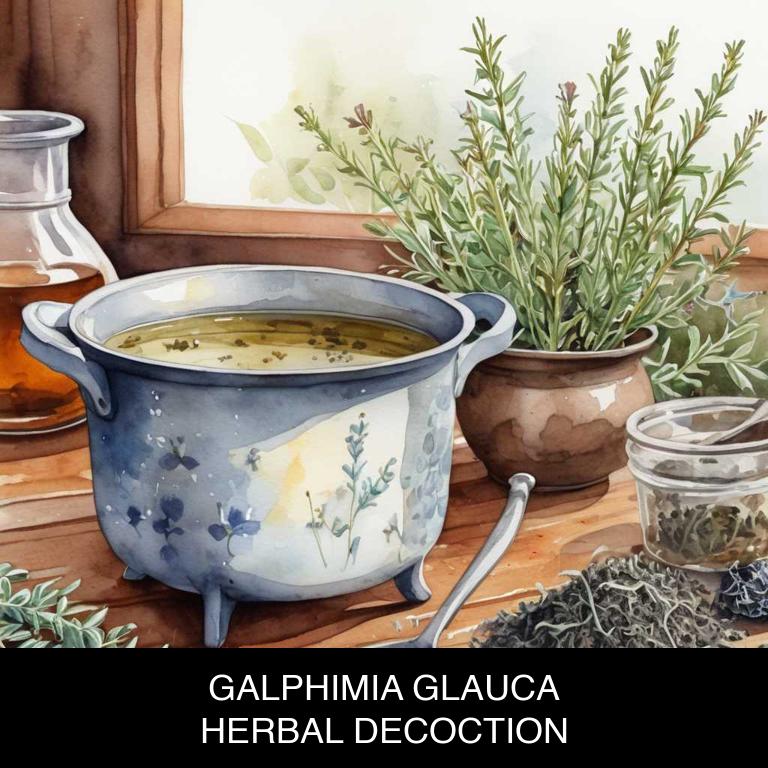
Medicinal Constituents
The list below shows the primary medicinal constituents in Galphimia glauca decoctions that help with hay fever.
- Flavonoids: These plant-derived compounds help with hay fever by exhibiting anti-inflammatory and antioxidant properties, which can reduce the allergic response and alleviate symptoms.
- Quercetin: A type of flavonoid, quercetin helps with hay fever by inhibiting the release of histamine, a key chemical involved in allergic reactions, thereby reducing symptoms such as itching, sneezing, and congestion.
- Kaempferol: Another flavonoid found in Galphimia glauca, kaempferol may help with hay fever by scavenging free radicals and reducing inflammation, which can contribute to the development and severity of allergic symptoms.
Parts Used
The list below shows the primary parts of yellow flower used to make decoctions for hay fever.
- Leaves: The leaves of Galphimia glauca are commonly used for decoctions due to their anti-inflammatory and antihistamine properties.
- Flowers: The flowers of Galphimia glauca are commonly used for decoctions due to their potential to alleviate hay fever symptoms.
- Roots: The roots of Galphimia glauca are commonly used for decoctions due to their potential to reduce inflammation and alleviate allergy symptoms.
Quick Recipe
The following recipe gives a procedure to make a basic yellow flower for hay fever.
- Harvest approximately 30 grams of galphimia glauca leaves and flowers in the early morning.
- Dry the harvested material in a well-ventilated area at 40 degrees celsius for 2 hours.
- Grind 2 grams of the dried material into a fine powder using a mortar and pestle.
- Combine 1 gram of the powdered galphimia glauca with 100 milliliters of boiling water in a cup.
- Steep the mixture for 15 minutes then strain it using a fine-mesh sieve to obtain the decoction.
7. Stellaria media
Chickweed decoctions helps with hay fever because of its anti-inflammatory properties, which help to reduce swelling in the nasal passages and sinuses.
The decoction's antihistamine-like effects also relieve itching and sneezing caused by allergen exposure. Additionally, chickweed's expectorant qualities loosen and clear mucus from the respiratory tract, making it easier to breathe and reducing congestion.
As a natural remedy, chickweed decoctions provide a gentle yet effective way to alleviate hay fever symptoms without relying on pharmaceuticals.
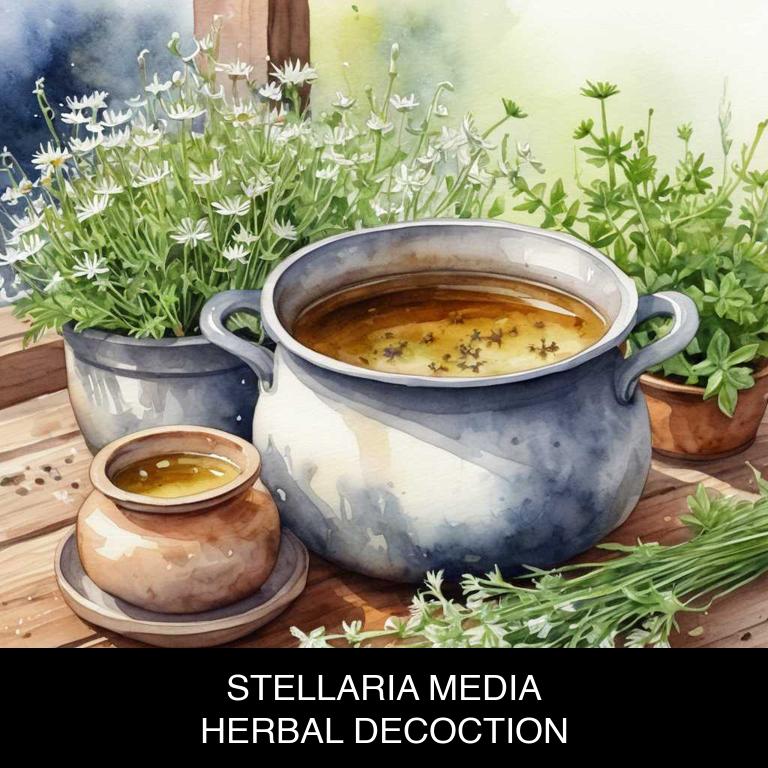
Medicinal Constituents
The list below shows the primary medicinal constituents in Stellaria media decoctions that help with hay fever.
- Flavonoids: These plant compounds have anti-inflammatory properties, which can help alleviate the allergic responses and inflammation associated with hay fever.
- Saponins: Saponins in Stellaria media have been shown to inhibit the release of histamine, a chemical mediator responsible for triggering allergic reactions and symptoms of hay fever.
- Coumarins: Coumarins in the plant have antioxidant and anti-inflammatory effects, which can help mitigate the oxidative stress and inflammation caused by exposure to allergens during hay fever.
Parts Used
The list below shows the primary parts of chickweed used to make decoctions for hay fever.
- Leaves: The leaves of Stellaria media are commonly used to make decoctions for hay fever because they contain flavonoids and salicylic acid, which have anti-inflammatory properties.
- Flowers: The flowers of Stellaria media are used to make decoctions for hay fever because they are rich in flavonoids, which have a calming effect on the respiratory system.
- Roots: The roots of Stellaria media are used to make decoctions for hay fever because they contain anti-inflammatory compounds that help reduce swelling in the nasal passages.
Quick Recipe
The following recipe gives a procedure to make a basic chickweed for hay fever.
- Gather 30-60 grams of dried stellaria media flowers and leaves for decoction preparation.
- Combine the dried plant material with 500-1000 ml of boiling water in a heat-resistant container.
- Reduce heat to a simmer and let the mixture steep for 10-15 minutes.
- Strain the liquid through a cheesecloth or fine-mesh sieve into a clean container.
- Store the herbal decoction in the refrigerator for up to 24 hours before consumption.
8. Althaea officinalis
Marshmallow decoctions helps with hay fever because they contain mucilages that soothe and calm irritated airways.
The anti-inflammatory properties of marshmallows reduce congestion and swelling, making it easier to breathe. Additionally, the decoction's expectorant properties help loosen and clear out excess mucus, providing relief from coughing and sneezing.
By reducing inflammation and congestion, marshmallow decoctions can alleviate symptoms associated with hay fever, such as runny nose, itchy eyes, and scratchy throat.
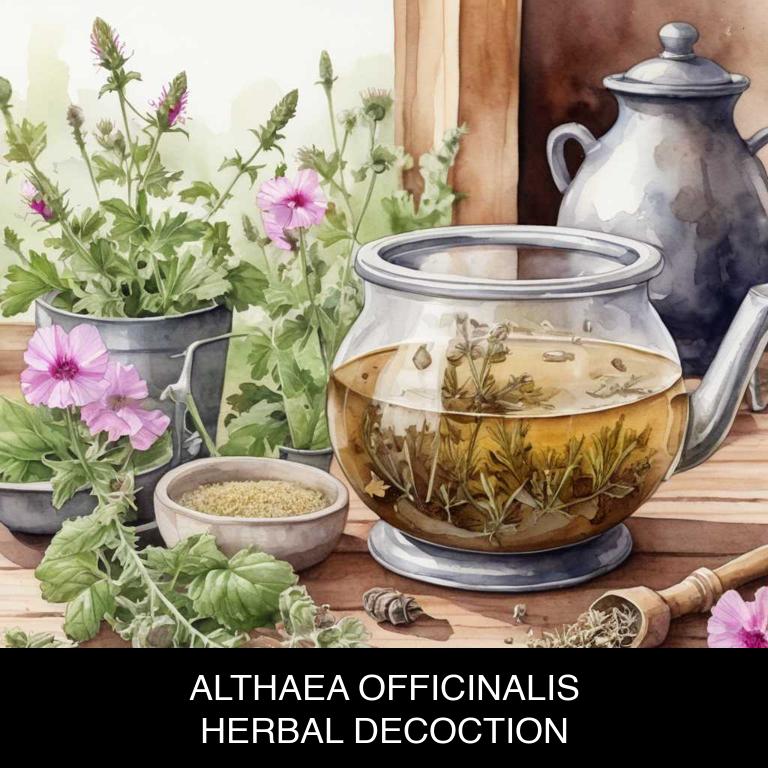
Medicinal Constituents
The list below shows the primary medicinal constituents in Althaea officinalis decoctions that help with hay fever.
- Flavonoids: These plant compounds help alleviate hay fever symptoms by reducing inflammation and inhibiting the release of histamine, a key contributor to allergic reactions.
- Saponins: These natural compounds have anti-inflammatory and antihistamine properties, which can help alleviate congestion, itching, and other symptoms associated with hay fever.
- Polysaccharides: These complex carbohydrates have immunomodulatory effects, which can help regulate the immune system's response to allergens and reduce the severity of hay fever symptoms.
Parts Used
The list below shows the primary parts of marshmallow used to make decoctions for hay fever.
- Roots: They are used due to their high mucilage content, which helps soothe and calm irritated tissues in the nasal passages and eyes.
- Leaves: They are used for their anti-inflammatory properties, which can help reduce swelling and ease congestion associated with hay fever.
- Barks: They are used due to their astringent and anti-inflammatory properties, which can help reduce nasal discharge and alleviate sinus pressure.
Quick Recipe
The following recipe gives a procedure to make a basic marshmallow for hay fever.
- Gather 40 grams of dried althaea officinalis root and rinse it with cold water to remove impurities.
- Combine the rinsed root with 1 liter of boiling water and let it steep for 10 to 15 minutes.
- Strain the liquid through a cheesecloth or a fine-mesh sieve into a bowl to remove the solids.
- Discard the solids and store the decoction in a clean glass bottle in the refrigerator for up to 3 days.
- Use 20 to 30 milliliters of the decoction 2 to 3 times a day as needed to soothe digestive issues.
9. Calendula officinalis
Pot marigold decoctions helps with hay fever because they possess anti-inflammatory properties that soothe irritated nasal passages and sinuses.
The decoction's flavonoids and phenolic acids work together to reduce inflammation, making it easier to breathe and alleviate congestion caused by allergies. Additionally, the antioxidants in pot marigold decoctions help combat oxidative stress, which can exacerbate hay fever symptoms.
By drinking this herbal decoction regularly, individuals may experience relief from seasonal allergy discomforts, allowing them to enjoy the outdoors without the burden of hay fever symptoms.

Medicinal Constituents
The list below shows the primary medicinal constituents in Calendula officinalis decoctions that help with hay fever.
- Phenolic acids: These compounds have anti-inflammatory properties, which can help alleviate symptoms of hay fever, such as congestion and swelling.
- Flavonoids: Flavonoids, particularly quercetin and kaempferol, have been shown to possess anti-inflammatory and antioxidant properties, which can help reduce histamine release and alleviate hay fever symptoms.
- Calendulin: Calendulin, a triterpene saponin, has been found to have anti-inflammatory and immunomodulatory effects, which can help regulate the immune response and alleviate symptoms of hay fever.
Parts Used
The list below shows the primary parts of pot marigold used to make decoctions for hay fever.
- Flowers: They are the most commonly used part due to their anti-inflammatory and antihistamine properties, which help alleviate hay fever symptoms.
- Leaves: Leaves are used due to their soothing and anti-inflammatory effects, which can help reduce nasal congestion and itching associated with hay fever.
- Stems: Stems are utilized due to their ability to reduce inflammation and relax the airways, providing relief from hay fever symptoms such as congestion and coughing.
Quick Recipe
The following recipe gives a procedure to make a basic pot marigold for hay fever.
- Harvest 20-30 calendula flowers and rinse them with filtered water to remove dirt and debris.
- Combine the calendula flowers with 2 cups of boiling water in a heat-resistant glass container.
- Steep the mixture for 5-7 minutes to allow the flowers to infuse their properties into the water.
- Strain the decoction through a cheesecloth or a fine-mesh sieve into a clean glass container.
- Store the decoction in the refrigerator for up to 3 days or freeze it for longer preservation.
10. Plantago major
Plantain decoctions helps with hay fever because of its natural anti-inflammatory and antihistamine properties.
The plant's active compounds, such as mucilage and triterpenoids, work together to soothe and calm irritated nasal passages and sinuses, reducing inflammation and congestion caused by allergens.
As a result, plantain decoctions can provide relief from hay fever symptoms like runny nose, itchy eyes, and sneezing, helping to alleviate discomfort and improve overall respiratory health.
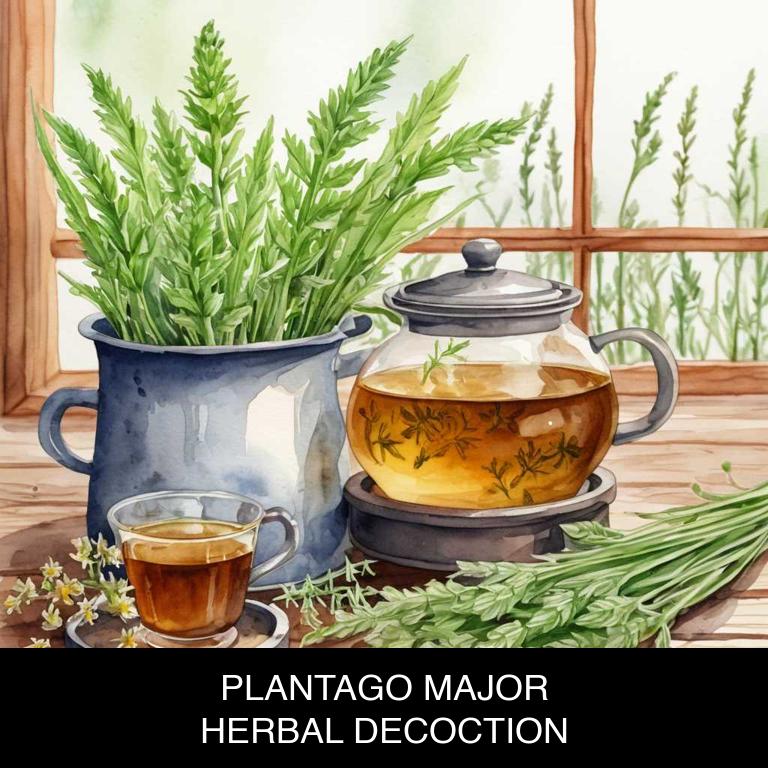
Medicinal Constituents
The list below shows the primary medicinal constituents in Plantago major decoctions that help with hay fever.
- Apolipoprotein b: It helps with hay fever by reducing the levels of IgE antibodies, which are responsible for triggering allergic reactions.
- Fatty acids: The fatty acids present in Plantago major, particularly linoleic and linolenic acids, exhibit anti-inflammatory properties, which help alleviate symptoms of hay fever such as itching and congestion.
- Flavonoids: These flavonoids have antioxidant and anti-inflammatory properties, which help reduce the production of pro-inflammatory cytokines and prevent the release of histamine, a key player in allergic reactions.
Parts Used
The list below shows the primary parts of plantain used to make decoctions for hay fever.
- Leaves: Used for their anti-inflammatory and antihistamine properties to alleviate hay fever symptoms.
- Flowers: Used for their soothing and anti-inflammatory effects to calm the respiratory system during hay fever attacks.
- Roots: Used for their anti-inflammatory and immunomodulatory properties to regulate the body's response to allergens.
Quick Recipe
The following recipe gives a procedure to make a basic plantain for hay fever.
- Measure 2 tablespoons of dried plantago major leaves into a heat-resistant glass container.
- Combine 1 cup of water with the measured plantago major leaves in the container.
- Heat the water over low heat for 10 to 15 minutes or until the liquid has reduced slightly.
- Strain the decoction through a cheesecloth or fine-mesh sieve into a clean container to remove solids.
- Allow the decoction to cool to room temperature before storing it in the refrigerator for up to 2 days.
What is the best combination of herbal decoctions to use for hay fever?
The best combination of herbal decoctions that help with hay fever is a blend of Quercetin-rich sage, anti-inflammatory turmeric, and soothing licorice root.
Sage helps to reduce histamine levels, turmeric reduces inflammation and congestion, while licorice root calms the nasal passages and soothes the respiratory tract.
A 50/30/20 ratio of sage to turmeric to licorice root can be used to create a decoction that can be consumed as a tea, helping to alleviate symptoms of hay fever and promote overall respiratory health.
What ailments similar to hay fever are treated with herbal decoctions?
Ailments similar to hay fever that are treated with herbal decoctions are allergies, sinusitis, and bronchial asthma.
Decoctions made from herbs like Stinging Nettle, Echinacea, and Marshmallow root help alleviate symptoms such as congestion, itching, and coughing.
These herbs work by reducing inflammation, soothing the respiratory tract, and improving immune function.